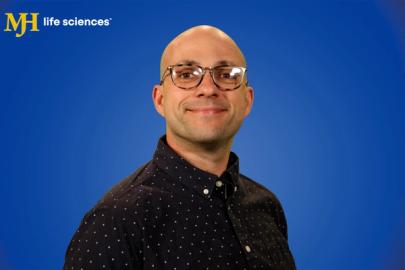- About Us
- Advertise / Support
- Editorial Board
- Contact Us
- CancerNetwork.com
- TargetedOnc.com
- OncLive.com
- OncNursingNews.com
- Terms & Conditions
- Privacy
- Do Not Sell My Information
- Washington My Health My Data
© 2025 MJH Life Sciences™ and CURE - Oncology & Cancer News for Patients & Caregivers. All rights reserved.
Breaking Down Gastrointestinal Stromal Tumor Basics

A nationally-published, award-winning journalist, Alex Biese joined the CURE team as an assistant managing editor in April 2023. Prior to that, Alex's work was published in outlets including the Chicago Sun-Times, MTV.com, USA TODAY and the Press of Atlantic City. Alex is a member of NLGJA: The Association of LGBTQ+ Journalists, and also performs at the Jersey Shore with the acoustic jam band Somewhat Relative.
Dr. Ajay Gupta sat down with CURE to explain the basics of gastrointestinal stromal tumors, highlighting what patients with this disease need to know.
CURE recently sat down with Dr. Ajay Gupta of the Roswell Park Comprehensive Cancer Center in Buffalo, New York, to discuss the basics of gastrointestinal stromal tumors (GIST), highlighting what patients with disease should know.
Gupta, a clinician and researcher, is a pediatric oncologist with the Roswell Park Oishei Children’s Cancer and Blood Disorders Program, and he has secondary appointments in the Department of Medicine and the Department of Cancer Genetics and Genomics. He specializes in sarcomas in children, adolescents and young adults (AYA), with a specific interest in Ewing sarcoma, osteosarcoma and soft tissue sarcomas. Additionally sees pediatric and adult patients as well as adults with neurofibromatosis (NF) in Roswell Park’s NF Multidisciplinary Clinic.
CURE: Can you explain what a gastrointestinal stromal tumor (GIST) is and how it is typically treated?
Gupta: Gastrointestinal stromal tumor is a solid tumor that we usually see in the stomach, but it can occur anywhere else along the gastrointestinal tract. Sometimes we'll see it along the small intestine, but sometimes we'll see something called extragastric intestinal stromal tumors, or AGIST. Overall, they aren’t just found around the stomach, but the stomach is certainly the most common location for them.
The other main thing to know is GISTs are characterized by certain mutations. For example, you have your KIT and EGFR mutations, and these characterize approximatley 80% to 90% of GIST tumors. That is something that was highlighted on the cover of Time magazine in 2001 when Gleevec (imatinib) first came out. It specifically has KIT as one of its targets, or what we call a tyrosine kinase inhibitor (TKI).
When Gleevec was invented, or when it came out, that was a game-changer for patients with GIST, because they previously had no targeted treatment, and now all of a sudden, you are having patients surviving for long periods of time.
What new treatment options, like TKIs, are available for GIST patients?
Recently, there's been an explosion of other TKIs that have been developed for GIST. Initially we started with Sutent (sunitinib), and then after that, Stivarga (regorafenib), followed by ripretinib. TKI after TKI have been developed, and now, different companies are developing more targeted agents.
Are there any particular patient populations that are at a greater risk for developing GIST in their lifetime?
Patients with NF1 can get GISTS more often. There are certain mutations that lead to GISTS that aren't your typical KIT or EGFR alpha. If you have those mutations, you could be potentially predisposed to GIST, but more often than not, they're sporadic, and there's no family history that predisposes.
How common are GISTs, and how are they typically treated?
It's probably one of our more common sarcomas, so to speak. They fall under the sarcoma category, but they're treated by both sarcoma oncologists and gastrointestinal doctors as well.
However, I would say there's about 10 to 15 cases per million, so maybe about 5,000 cases a year in the U.S., if I had to guess, so, quite a few. They're treated all over. They're treated at large cancer centers. They're treated in the in the community by surgeons who resect them, so you don't always get treatment more than surgery if it's a low-risk GIST. There are different risk categories that help us kind of prognosticate whether the GIST is going to come back after surgery.
Transcript has been edited for clarity and conciseness.
For more news on cancer updates, research and education, don’t forget to subscribe to CURE®’s newsletters here.
Related Content:

